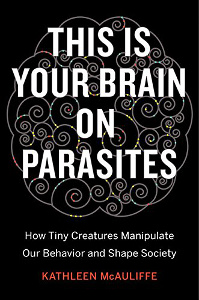 Full Title: This Is Your Brain on Parasites: How Tiny Creatures Manipulate Our Behavior and Shape Society
Full Title: This Is Your Brain on Parasites: How Tiny Creatures Manipulate Our Behavior and Shape Society
First Published: 7th June, 2016
Genre: Science Non-Fiction
Available: Amazon.com | Amazon UK
This is a science non-fiction book, looking at the ways parasites manipulate behaviour. A broad definition of parasite is used, which includes parasitoids. It also looks at things like behaviours that have evolved to avoid getting infected.
Many parasites are talked about in detail, including how the parasite was researched. Though not intended as the book’s main theme, that part was also of interest. It shows how science is often hampered by who can get funding or fund their own research.
The style is accessible to people with little knowledge of science. Basic concepts are explained, such as insects being able to make decisions. It’s important to realise they’re not instinct machines in order to understand that a parasite could knock out their ability to make choices.
One thing that stands out with the parasite examples is a lot are rather more subtle and cunning than the average science fiction parasite. Some do take over the bodies of their hosts completely, but often it’s not that extreme. For example, humans are sent running to water, thus allowing the parasite to release offspring into the water. All it requires is making the skin feel like it’s burning. No direct brain control is required.
The positive aspects of parasites are discussed briefly. An example was crickets being made to jump into the water, which provided a meal for a rare trout. Without the parasite, there might not have been trout. The ecology of parasites is complicated, which has implications when it comes to trying to eradicate certain parasites. It could have unexpected results.
Where the book fell down for me was discussing humans. It wasn’t about what was covered. Examples include how gut bacteria might influence someone’s weight, and parasites as an environmental factor in schizophrenia. It also touches on how inequality can alter the chances of someone being impacted by harmful parasites, such as Toxocara infections being less common in White Americans and more common in African Americans.
Though a lot of that information is interesting, the perspective it was presented from wasn’t comfortable. It’s written from a privileged perspective that assumes the reader will be too, so mental illness is a tragedy and fatness is a disease. When saying people shown images of sick people become more prejudiced against those who are different to them, like disabled people and immigrants, it’s making a statement about who is the default person and who is different.
This is a wider issue when it comes to science, as it can mean studies miss the obvious and programmes based on the research fail to understand the communities they’re supposed to help. A research example was the scientist who tried to use the smell of durian to make his research participants feel disgust. But he’d not taken into account that many were Asian and were used to it. This is such an obvious thing that it really shouldn’t have needed to hit the lab before someone figured it out. Yet it’s portrayed as the surprise that no one could have predicted. Shock horror: you won’t feel disgusted by foods you’ve grown up eating and enjoying.
I liked this book when it was about wasps making cockroaches indecisive. It contains a lot of examples, and would be a valuable starting point for science fiction writers wanting to expand their basic knowledge. It also has a bibliography to aid with continued research. But once it starts talking about people, it hits the common non-fiction territory of wading through a series of microaggressions (and some not so micro ones) to get to the information. I could have done without that part.
[A copy of this book was received from the publisher for review purposes]